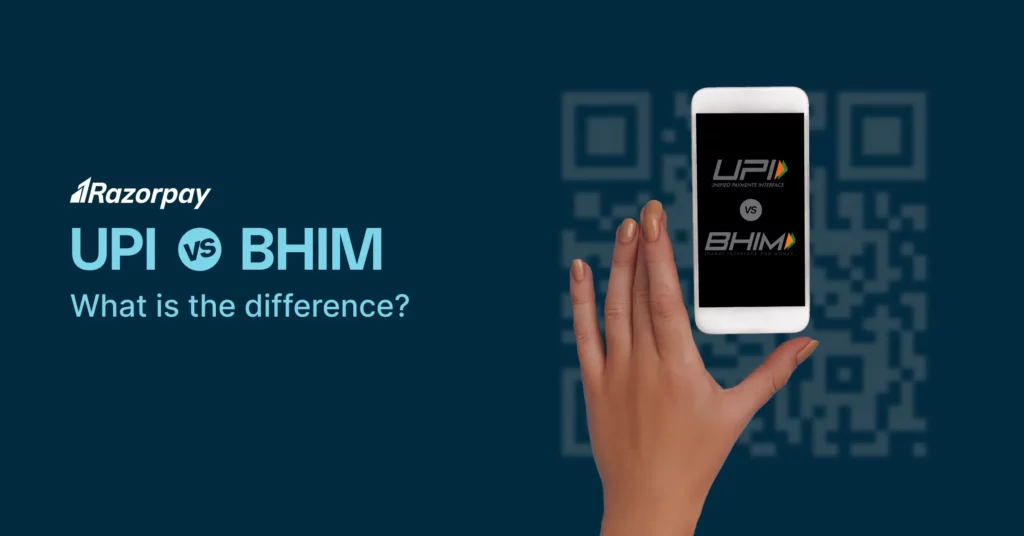Digital transactions have become a convenient and secure way of transferring money in India, with UPI taking the lead. Many people tend to use the terms BHIM and UPI interchangeably, not knowing the differences between them.
Let’s discuss the UPI vs BHIM to help you make informed choices when using digital payment in India.
Table of Contents
Difference Between BHIM and UPI
BHIM stands for Bharat Interface for Money. It is a mobile payment app that allows users to make quick bank transactions using the Unified Payments Interface (UPI). On the other hand, UPI stands for Unified Payments Interface. It is an instant payment system that allows users to transfer money between bank accounts instantly through a single mobile app.
Feature |
UPI |
BHIM |
| Development and Purpose | Underlying platform for multiple apps | Standalone payment app |
| User Interface and Experience | Varies across apps | Simplified and intuitive |
| Transactions | Person-to-person, bill payments, merchant transactions | Primarily person-to-person |
| Language Support | Varies across apps | Multiple languages |
| Transaction Limits | Individual: Rs. 1 lakh<br>Daily: Rs. 5 lakh (bill payments, merchant transactions) | Individual: Rs. 1 lakh<br>Daily: Rs. 1 lakh (single bank account) |
| Branding and Availability | Multiple apps with distinct branding | Standalone app |
UPI vs BHIM: Detailed Explanation
Here’s the deep understanding of each features:
1. Development and Purpose
BHIM was explicitly developed as a standalone payment app, while UPI is the underlying platform for BHIM and other UPI-enabled apps. BHIM is solely focused on providing a user-friendly interface for digital payments, whereas UPI is the infrastructure that allows multiple apps to access the UPI payment system.
2. User Interface and Experience
BHIM offers a simplified user interface with an intuitive design, making operating and initiating transactions simple. Conversely, UPI caters to a broader range of apps, each with its unique user interface based on the individual app’s design choices.
3. Transactions
BHIM primarily focuses on person-to-person payments with a streamlined approach. In contrast, UPI encompasses various transaction options on different apps, including bill payments and merchant transactions.
4. Language Support
BHIM supports multiple languages, making it accessible to users across India. While some UPI-enabled apps offer multi-language support, others may have limited language options.
5. Transaction Limits
Both BHIM and UPI have a limit of Rs. 1 lakh for individual transactions. However, there are variations in the maximum daily limits. For BHIM, the maximum limit is Rs. 1 lakh per day for a single bank account linked to the app. In contrast, UPI allows a maximum limit of Rs. 5 lakh for bill payments and merchant transactions.
6. Branding and Availability
BHIM is branded as a standalone app. In contrast, UPI is utilized by multiple apps with their distinct branding. As a result, UPI offers users diverse options to pick from when it comes to digital payment apps.
What is UPI?
UPI (Unified Payments Interface) is an advanced payment system developed by the NPCI (National Payments Corporation of India). It facilitates seamless fund transfers between different bank accounts.
The UPI payment system offers a user-friendly interface for sending and receiving money via a virtual payment address or UPI ID without the need for traditional bank details. It is bank-agnostic, meaning that it works with multiple banks. You can create a unique UPI ID for bank accounts with different banks.
UPI transactions can be performed 24/7. UPI offers multiple transaction options, such as Scan and Pay, request money, bill payments, and merchant payments.
UPI has several advantages over other payment methods, such as simplified fund management, instant payment notifications, and low transaction costs. UPI provides real-time updates by sending instant notifications to both the sender and the receiver after every transaction.
Read More About: What is UPI and How it Works?
What is BHIM?
BHIM (Bharat Interface for Money) is an innovative digital payment solution crafted by the NPCI. It was launched as part of the government’s initiative to promote cashless transactions and digital payments in India. BHIM is built on the UPI platform, offering a simplified user interface for secure and convenient transactions.
The BHIM app has several key features that make it user-friendly and accessible:
-
It supports multiple languages, including Hindi, English, Tamil, Telugu, Malayalam, Bengali, and more.
-
Available on both Android and iOS, the BHIM app permits you to perform transactions using mobile numbers, UPI IDs, or QR codes.
-
You can check your account balance, transaction history, and pending requests on the app.
The BHIM app offers many benefits, such as security, reliability, speed, and nationwide acceptance. The BHIM app adheres to the NPCI security standards, ensuring the transactions are encrypted and authenticated. It facilitates real-time money transfers to any bank account and is widely accepted by merchants across sectors like retail, e-commerce, education, health, etc. You can enjoy discounts, cashback, and rewards upon transacting via the BHIM app.
Conclusion
In conclusion, while both BHIM and UPI are significant players in India’s digital payment landscape, they serve distinct purposes. BHIM is a user-friendly mobile app built on the UPI platform, providing a simplified interface for various transactions. UPI, on the other hand, is the underlying technology that powers numerous digital payment apps, enabling real-time, secure, and convenient money transfers.
Frequently Asked Questions (FAQs)
1. Is BHIM more secure than other UPI apps?
BHIM and other UPI apps follow the same security protocols mandated by the Reserve Bank of India (RBI). The security of any UPI app, including BHIM, depends on various factors, such as the strength of your passcode, the security features implemented by your bank, and your awareness and caution while using digital payment gateway in India.
2. Can I link multiple bank accounts to BHIM and UPI?
Yes, both BHIM and UPI allow you to link multiple bank accounts. You can seamlessly switch between different accounts for making transactions or checking balances.
3. Are there any fees associated with using BHIM or UPI?
No, BHIM and UPI do not charge any fees for using their services. Transactions made through these platforms are free of cost. However, you must check with your bank regarding any charges they may impose for specific services related to UPI transactions.
4. Which should i choose, BHIM or another UPI app?
The choice between BHIM and other UPI apps depends on your personal preferences and requirements. While BHIM is a dedicated app developed by the NPCI, other UPI apps offered by different banks may provide additional features or benefits specific to their respective platforms.


